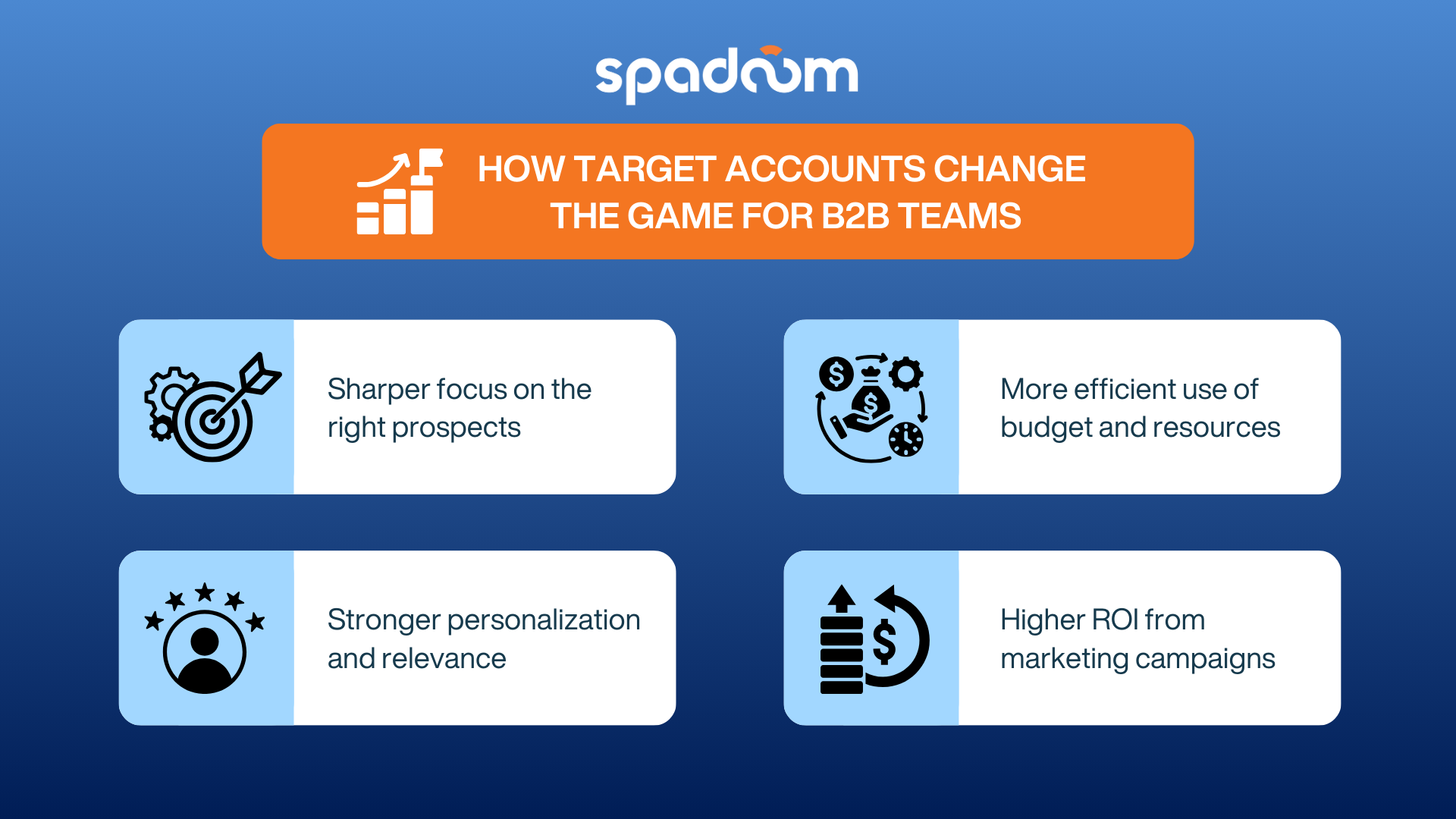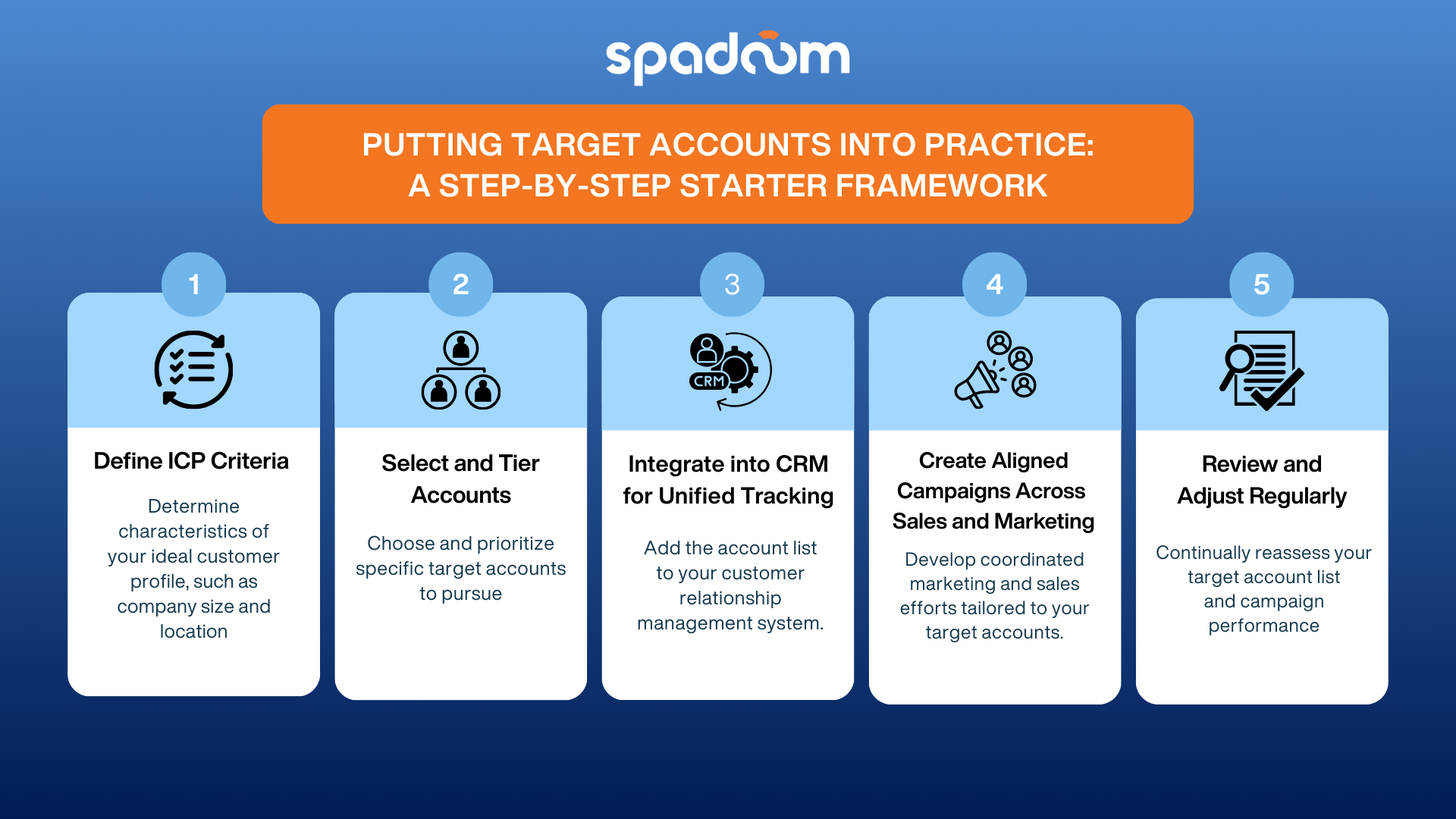In B2B sales and marketing, success often depends less on the number of leads and more on focusing on the right ones. That is where target accounts come into play. These are the companies that hold the highest potential value for your business, and making them the center of your efforts is what separates scattered outreach from a well-coordinated growth strategy.
Target accounts sit at the heart of many modern CRM strategies because they help teams sharpen focus, avoid wasted effort, and work toward shared objectives. When sales and marketing rally around the same accounts, they can deliver consistent messaging, streamline campaigns, and measure progress in a unified way.
Its value becomes even more evident when you look at the results: RollWorks reports that Payscale, after adopting an account-based marketing strategy, generated six times more revenue from their target accounts in just seven months and saw a 500% increase in target-account website traffic.
In today’s blog, we will explore what target accounts are, why they matter, how they bring sales and marketing into alignment, and the practical steps you can take to put them at the center of your B2B growth strategy.
What Is a Target Account?
A target account is a company that a business deliberately prioritizes because it closely matches the profile of an ideal customer.
Unlike a general lead that may or may not be a good fit, a target account is selected through a careful process that looks at factors such as industry relevance, revenue potential, and buying influence. The goal is to channel time and resources into accounts with the highest likelihood of conversion and long-term value.
Target Accounts vs. Key Accounts
It is useful to distinguish target accounts from key accounts. Key accounts are typically existing customers who already generate significant revenue and require strong ongoing relationship management.
Target accounts, on the other hand, are future-facing. They represent new opportunities that align with a company’s strategic objectives, offering potential for growth and expansion. Understanding this difference helps organizations balance retention of current clients with the pursuit of new business.
Identifying Target Accounts Through an Ideal Customer Profile
The process of identifying target accounts usually begins with defining an Ideal Customer Profile (ICP). This profile outlines the attributes of companies most likely to benefit from your product or service. Common criteria include company size, geographic presence, industry segment, budget capacity, and the presence of decision-makers who can influence purchasing.
According to Foundry, organizations that clearly define their ICP achieve 68% higher win rates on their target accounts, showing the measurable value of getting this step right.
A straightforward example can make this easier to picture. Consider a SaaS company that specializes in compliance software. Instead of marketing broadly, they may decide to prioritize healthcare providers, as these organizations face strict regulatory requirements and have both the need and budget for reliable compliance solutions.
By focusing on these accounts, the company directs its sales and marketing teams toward opportunities with a higher chance of success.
Why Target Accounts Align Sales and Marketing
One of the most persistent challenges in B2B organizations is the divide between sales and marketing. Marketing teams often invest in nurturing a wide pool of leads, while sales teams may be focused on a smaller set of prospects that appear immediately promising.
This disconnect leads to duplication of effort, inconsistent outreach, and missed opportunities, ultimately slowing down growth.
From Disconnected Efforts to a Shared Playbook
Target accounts resolve this issue by giving both sides a shared foundation. When sales and marketing agree on which companies matter most, they can coordinate their activities more effectively.
Campaigns are designed with the same accounts in mind, and outreach efforts become complementary instead of fragmented. This shared playbook ensures that both teams are moving in the same direction, speaking the same language, and working toward the same outcomes.
How This Alignment Results in Accelerated Growth
When sales and marketing focus on the same accounts, progress speeds up, campaigns hit the right audiences, and trust builds faster, making deals easier to close. Sales cycles often shorten because prospects encounter aligned communication at every stage, and conversion rates improve as qualified opportunities move through the pipeline more smoothly.
Research by Gartner, reported by The CMO, shows that account-based programs can increase overall pipeline conversion rates by 14% and boost the rate of converting marketing-qualified leads to sales-accepted leads by about 25% when teams align around target accounts.
Technology plays an important role as well in making this alignment work. A well-implemented CRM system ensures both teams track the same accounts, share insights in real time, and measure progress on common terms, setting the stage for realizing the full benefits of a target account approach.
How Target Accounts Change the Game for B2B Teams

Shifting to a target account approach transforms how B2B teams prioritize and deliver their efforts. Instead of spreading time and resources across a broad audience, businesses can concentrate on the accounts that matter most.
The advantages become clearer when you look at the specific ways target accounts reshape performance.
Focused prospecting that saves time: By working only with accounts that match the ideal profile, teams avoid chasing leads with little chance of success. WebFX reports that account-based marketing can cut wasted prospecting time by 50%, a strong sign of how precision improves productivity.
Personalization that resonates with decision-makers: When businesses know exactly who they are targeting, they can adapt their messaging to fit the industry, role, or specific needs of decision-makers. Outreach becomes more relevant, conversations feel more meaningful, and trust is built more quickly than with generic campaigns.
Higher returns on marketing investment: Return on investment is one of the strongest reasons for adopting a target account strategy. Denave found that 80% of marketers believe account-based programs deliver higher ROI than other types of marketing initiatives. With clear priorities and a narrowed focus, every campaign has a better chance of reaching the right audience and producing measurable returns.
Steps to Put Target Accounts into Practice

The first step is to define your Ideal Customer Profile (ICP). This means outlining the characteristics of companies most likely to benefit from your solution, such as revenue size, location, and industry. Having this clarity up front ensures that you are targeting organizations that fit your strengths and long-term goals.
Once the ICP is clear, the next step is to select and tier accounts. Not every potential customer will have the same level of importance, so grouping them into categories such as high, medium, and low priority helps focus resources. High-priority accounts might warrant personalized campaigns, while lower tiers can be nurtured through broader outreach.
To make these efforts actionable, integrating the accounts into a CRM system is essential. A shared platform allows both sales and marketing teams to see progress in real time, track engagement, and coordinate outreach. This ensures accountability and keeps everyone aligned on the same list.
With the foundation in place, it is time to create aligned campaigns. This could include digital ads, tailored email sequences, or relevant content targeted specifically at decision-makers within those accounts.
Finally, businesses should review and adjust regularly. Quarterly reviews help identify what is working, where challenges exist, and how to refine the account list or campaigns for better results moving forward.
Putting Target Accounts into Action with Spadoom
Building a target account strategy is only effective when supported by the right systems and expertise. At Spadoom, we help organizations design their CRM environment to fully support account-based growth, from early planning to hands-on rollout.
With deep experience in SAP CRM solutions across Switzerland, Austria, and Germany, our consultants guide organizations through every step of CRM system implementation. From structuring account data to enabling cross-team visibility, we make sure the focus on target accounts translates into measurable growth and stronger customer relationships.
Contact us today to discover how Spadoom can help your business align sales and marketing with the power of SAP CRM solutions.



